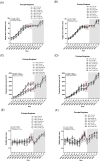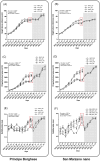Phenotyping as a tool to study the impact of seed priming and arbuscular mycorrhizal fungi on tomato response to water limitation
- PMID: 40569661
- PMCID: PMC12265891
- DOI: 10.1093/femsle/fnaf064
Phenotyping as a tool to study the impact of seed priming and arbuscular mycorrhizal fungi on tomato response to water limitation
Abstract
This study explores the effects of natural seed priming compounds (i.e. chitosan alone and in combination with salicylic acid or melatonin) with the symbiosis of arbuscular mycorrhizal fungi (AMF) on the capability of two Italian tomato varieties (Principe Borghese and San Marzano nano) to withstand water deprivation through high-throughput plant phenotyping technology. Plant responses have been automatically evaluated by integrating physiological, morpho-biometric, and biochemical data. Under water deprivation, AMF-inoculated plants exhibited enhanced physiological performance, by reducing oxidative damage and improving stomatal function. Digital phenotyping provides a non-invasive approach to assess the effects of external factors, such as the impact of mycorrhizal fungi on plant development. RGB (visible light) imaging enables the analysis of morphological traits like plant size and growth patterns, and of colorimetric changes used as a proxy of physiological responses. Biochemical analyses revealed increased carotenoid and flavonoid content in chitosan + salicylic acid-treated plants with AMF, particularly in Principe Borghese. Genotype-dependent differences were evident in terms of fruit production, where Principe Borghese plants showed significantly more red fruits in presence of AM fungus. The results underline the potential of combined AMF and natural compound application as a sustainable strategy for improving tomato resilience to water stress, contributing to resource-efficient agricultural practices and climate change mitigation.
Keywords: arbuscular mycorrhizal symbiosis; chemical priming; high-throughput plant phenotyping; stress adaptation; target metabolite analysis; water deficit.
© The Author(s) 2025. Published by Oxford University Press on behalf of FEMS.
Conflict of interest statement
The authors declare that the research was conducted in the absence of any commercial or financial relationships that could be construed as a potential conflict of interest.
Figures








Similar articles
-
Arbuscular mycorrhizal fungi and Trichoderma longibrachiatum alter the transcriptome of Vicia villosa in response to infection by the fungal pathogen Stemphylium vesicarium.BMC Microbiol. 2025 Feb 25;25(1):86. doi: 10.1186/s12866-025-03778-y. BMC Microbiol. 2025. PMID: 40000993 Free PMC article.
-
Arbuscular mycorrhizal fungi - a natural tool to impart abiotic stress tolerance in plants.Plant Signal Behav. 2025 Dec;20(1):2525843. doi: 10.1080/15592324.2025.2525843. Epub 2025 Jul 9. Plant Signal Behav. 2025. PMID: 40630045 Free PMC article. Review.
-
Inoculation with Talaromyces trachyspermus and arbuscular mycorrhizal fungus alongside sulfonylurea herbicides alters Orobanche aegyptiaca and tomato growth.Sci Rep. 2025 Jul 26;15(1):27184. doi: 10.1038/s41598-025-10177-w. Sci Rep. 2025. PMID: 40715192 Free PMC article.
-
Morphophysiological attributes of AMF inoculated tomato (Lycopersicon esculentum Mill.) ameliorated by resorcinol, biochar and nanobiochar.Discov Nano. 2025 Jul 28;20(1):122. doi: 10.1186/s11671-025-04307-6. Discov Nano. 2025. PMID: 40721547 Free PMC article.
-
Roles of arbuscular mycorrhizal fungi in plant growth and disease management for sustainable agriculture.Front Microbiol. 2025 Jul 23;16:1616273. doi: 10.3389/fmicb.2025.1616273. eCollection 2025. Front Microbiol. 2025. PMID: 40778206 Free PMC article. Review.
References
-
- Akhoundnejad Y, Baran S. Boosting drought resistance in pepper (Capsicum annuum L.) with the aid of arbuscular mycorrhizal fungi and key phytohormones. Horts. 2023;58:1358–67. 10.21273/HORTSCI17370-23. - DOI
-
- Alagna F, Balestrini R, Chitarra W et al. In: MA Hossain, F Liu, DJ Burrittet al. (eds.)Getting ready with the priming: innovative weapons against biotic and abiotic cropenemies in a global changing scenario. Priming-mediated stress and cross-stress tolerancein crop plants. New York: Academic Press, 2020, 35–56.
-
- Alam MZ, Choudhury TR, Mridha MaU. Arbuscular mycorrhizal fungi enhance biomass growth, mineral content, and antioxidant activity in tomato plants under drought stress. J Food Qual. 2023;2023:1. 10.1155/2023/2581608. - DOI
-
- Alvarez I, Diaz-Poso A, Lorenzo MN et al. Heat index historical trends and projections due to climate change in the Mediterranean basin based on CMIP6. Atmos Res. 2024;308:107512. 10.1016/j.atmosres.2024.107512. - DOI
MeSH terms
Substances
Grants and funding
LinkOut - more resources
Full Text Sources

